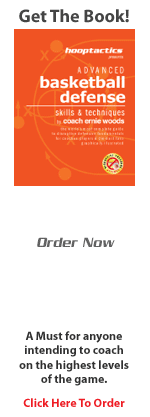Basketball Tips & Strategies – January 2009
Quick Tip: Teaching & Learning
To be successful players must gain a working knowledge of the game. What, when and why should be very clear and specific. Learning is best when it includes activities using as many senses as possible. Learners remember 10% of what is read, 20% of what is heard (75% is forgotten after 2 days), 30% of what is seen (majority of learning), and 50% of what is heard and seen. Different players learn in different ways and rates. Encourage players to learn individually, in pairs and in teams. Learning is further enhanced when it is relevant and fully understood by the learner, such as the importance of boxing out on rebounds.
Coaching Tips: Developing an Inbounder Passer
It is not so easy to inbound ball. Most players and coaches take making an inbounds pass for granted. However, in making an inbounds pass, the passer is facing a five against four defensive advantage and only has five (5) seconds in which to locate a receiver and make a successful inbounds pass. In addition, to this numerical disadvantage, by rule the inbounder cannot move, except after a made shot. This provides the defense with the opportunity to jam or smother the passer very effectively. Also, on baseline out of bound situations, the backboard comes into play and becomes a real obstacle in which that the inbounds passer has to contend.
Many of championships have been lost because teams were not able to inbound ball at end of game. Players on all levels, including the NBA and WNBA, need to know and practice the fundamental skills and concepts required in making a successful inbound pass. In additional to the physical skills involved, good inbound passers must possess a strong commitment to team play since they are taken for granted and very rarely rewarded for the efforts. However, good inbounders are vital, and a team will not win a championship without one. To learn more – Premium Members Click Here
Disrupting “On-Ball” Screens
The number of teams that are using On-Ball screens (screen & roll) as an integral part of their offensive is increasing. Since On-Ball screens can produce a variety of quick hitting options, they pose a real threat to any team that is not prepared to defend them. On-Ball screens require a total team effort to stop. The ball handler should be influenced and forced to dribble in a direction away from the screen. The screener’s attempt to set a screen should be disrupted, and the helpside defenders must rotate over to prevent or disrupt the roll option. Therefore, communication, teamwork, and aggressiveness are key components in defending against the On-Ball screen. Learn more – Premium Members Click Here
Player Tips: Rebounding Offensively
Rather than size and strength along with teamwork that is required for defensive rebounding, offensive rebounding is an individual effort requiring anticipation, determination, and hustle. Players must develop an attitude as well as an instinct for the ball. They must be aggressive and determined, and 2nd and 3rd efforts should be common place.
The most important key to offensive rebounding is getting to the right place at the right time. In order to accomplish this, players must be active during FLIGHT TIME (the time it takes the ball to leave the shooter’s hand and descends to a point where it can be rebounded). During this time players must determine distance as well as the proper angle of rebound. However, close to 70% of the time shot will rebound off to opposite side of basket. Also, the longer the shot the longer the rebound. Once in the proper rebounding area, players then need to establish inside position by boxing out the defender and avoid going over the back of the defensive player. Since most defensive players have a tendency to watch the flight of the ball and do not box out, all the offensive player has to do is simply step around the defender to establish inside rebounding position. However, in cases, where defenders do block out, offensive players need to know how to use arm over and spin techniques to get inside. To learn much more – Premium Memebers Click Here
Posted: January 1st, 2009 under Defensive Strategies | Offensive Strategies | Player Development.
Tags: Anticipation, Boxing Out, Communication, Disrupting On-Ball Screens, Flight Time, Learning, Offensive Rebounds, On-Ball Screens, Teaching, Teamwork





